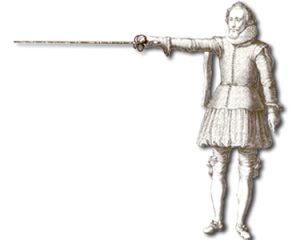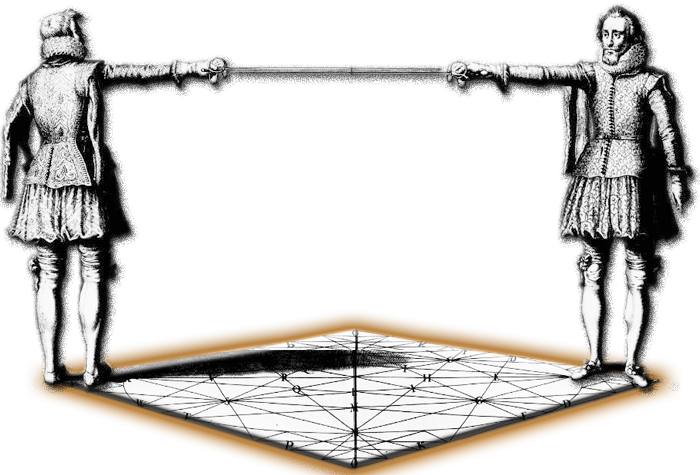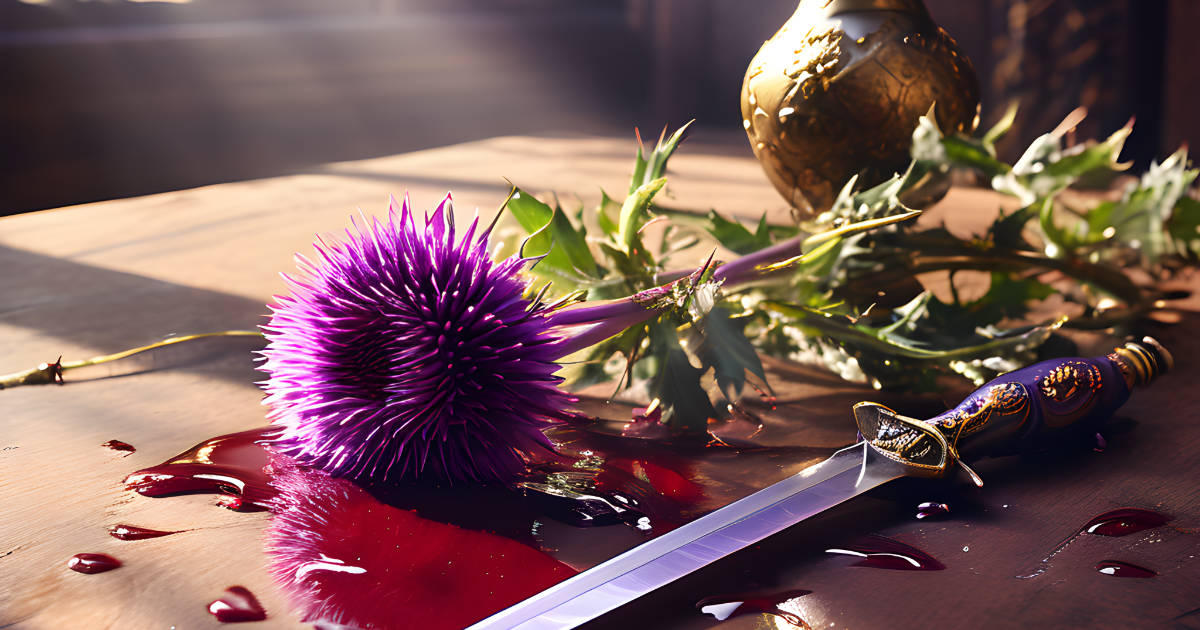For the love of this art I (Dubhglas of Annandale) have compiled this review of Girard Thibault d’Anvers Academy of the Sword (as Translated by John Michael Greer) upon the World Wide Web.
My Intent is to make available my personal study of this system, Illustrating key points while quoting brief passages, and providing additional illustrations and animation based upon my understanding. My interest is limited to the application of historical techniques within an enactment society.
I encourage anyone interested in this system to obtain a copy of:
Girard Thibault d’Anvers Academy of the Sword.
Academy de l’Espee
Academy of the Sword: wherein is demonstrated by mathematical rules on the foundation of a mysterious circle the theory and practice of the true and heretofore unknown secrets of handling arms on foot and horseback, (unfortunately the section on horseback was never written).
Time line:
( _ _ _~ 1600)
Jerónimo Sánchez de Carranza commonly called the “Father of Spanish Fencing”. His work on Destreza, was the foundation of a fighting system that lasted almost 300 years.
(1570 ~ 1640)
Don Luis Pacheco de Narváez, was a student of Carranza and a prolific fencing author. Some of his works were compendiums of Carranza’s while others were less derivative.
(1574 ~ 1629)
Gérard Thibault d’Anvers was a Dutch fencing master who first studied swordsmanship in Antwerp under Lambert van Someron, and latter in Spain, where he studied the system of Narváez. Before gaining some renown in his use of the Rapier, after returning to the Netherlands, and eventually publishing his treatise on rapier combat in 1630.
Thibault’s Method:
How much of Thibault’s system of combat was influenced by his study of the Spanish system and how much was derived from a Dutch system or his own genius, I cannot say.
I have not studied the works of Carranza, Narváez or Someron (Actually I haven’t been able to find any information on Somerons system).
Thibault humbly and quit universally referred to “his” system as “Ours”. I chose to study it because, quit simply it is a complete system from a master who lived, when a proficiency with a blade was an important aspect of life.
Thibault system does differs from his Spanish counterparts in many areas, including his preferred stance and grip (This grip in paramount in the use of his system).
Vitruvian Man
In chapter one Thibault compared our circle with the proportions of the body in chapter two he again compared it against the proportions of the human body as illustrated in Albrect Durer book of proportions. In order to demonstrate he hadn’t created his figure to support the radius of the circle.
I thought another overlays would be fun, so here is Leonardo da Vinci Vitruvain Man from 1487, his drawing and accompanying text is sometimes referred to as the Canon of Proportions.
Please note Thibault does not consider the placement of arm or finger in his calculations nor placing the legs as equilateral triangle, he simply uses the measure from the instep to the naval.
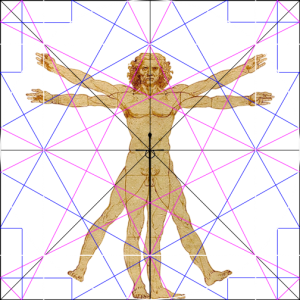
“if you open your legs enough that your head is lowered by one-fourteenth of your height and raise your hands enough that your extended fingers touch the line of the top of your head, know that the centre of the extended limbs will be the navel and the space between the legs will be an equilateral triangle”
Leonardo da Vinci
Our Circle
Thibault affirms that the proper measure of defense lies within the geometry of the individual duelist, this is the measure from the instep to the naval (Tip to quillian). This is the radius of your circle and the foundation of your movements. This blade length is also the maximum size of blade that can be conveniently carried, drawn and used for defense. Please note the intent of this system is not to simply “reach out” and touch someone at a safe distance, it’s about gaining an advantage and approaching your opponent with assurety.
The lines of figure One are labelled for reference, each is mirrored by quadrant to produce the complete circle as shown in figure Two. The lettered vertices become reference points of where to place your feet, not always on a letter sometimes adjacent to or between letters. Do not panic or think this system to complex, this arrangement is not intended to be memorized or visualized on the field. It’s purpose is to teach a natural pace, distancing and regulate movement during practice, not when sparing.
Think of it as a game of Renaissance “Twister”. For example your opponent raises their hand to grasp your blade while advancing their lead foot to letter “V” you counter by covering their blade with superiority while advancing to the second instance at letter “G”. But lets start with the basics, as after all “You must have wings before you can fly”.

Making your own Circle
Measure the distance from your instep to your navel, double it this will be the length of the Circumscribed Square, “the width and height” of your surface, be sure to allow for movement outside of the circle, at least the distance of your measure (blade length).
Next find a suitable surface, draw the Circumscribed Square, all corners must be 90 angles, use a chalk line to snap from corner to corner the lines of the Diameter, Perpendicular and oblique make sure the Oblique is at 90 angle to the Circumscribed Square.
Measuring out from the centre, place a tick mark along the Perpendicular and Diameter (this is the distance from your instep to naval “radius”). Snap a line between tick marks to create the Inscribed Square. Use a straight edge to draw the Quadrangle extending the Inscribed Square to the Circumscribed Square.
Using the vertices of the Inscribed Square and the lines of the Diameter and Perpendicular, snap the lines of the Inner Transverse and Inner Collaterals. Using the vertices of the Inner Transverse, Inner Collaterals, and Circumscribed Square snap the the lines of the Outer Collaterals and Outer Transverse Now use a string and chalk to draw the circle around the Inscribed Square, connect the dots to finish off the minor lines.
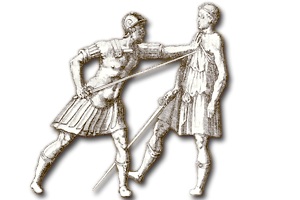
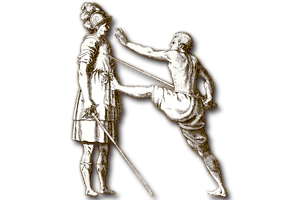
Long blades in close quarters
“In close quarters our sword-length does not cease to be sufficiently convenient or manageable; for it is easier to shorten one’s line at these short ranges than it is to elongate it at long range.”
The ESSENTIAL manner of holding the sword: If you don’t want to hold your sword in this manner stop right here, this system is not for you. If your hilt does not have a quillian extending on both sides of your guard, get one before continuing your study of this system. If you have any doubt allow me to be blunt, this style of hilt and method of grasping the sword is essential to Thibault’s methods.
This manner of holding the sword differs greatly from ordinary or usual practice. As represented here the index finger is placed within the guard over the outside arm of the quillian, and around the ricasso or “heel of the blade”; the thumb goes on the other side up against it, inside the guard similarly; the rest of fingers close tightly around the grip, so that the pommel is held firm inside the palm, and the quillian are horizontal and on the same level, if you have a knuckle bow it will always be on your outside line. This is essential in this system of defence.
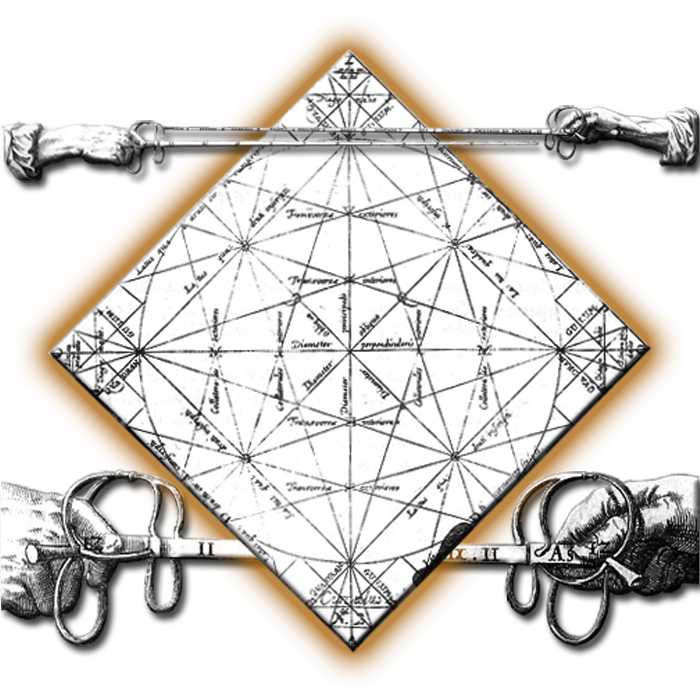
The sword is divided into twelve degrees of force from the point “Zero” to the quillian “Twelve”. The point is the foible (weakest part 0), the hilt is the forte (strongest part 12). As a general rule the attacking blade will be intercepted around the area of the fourth degree by the defenders blade around the eighth degree.
The Natural Step and Measure
This is a brief over view of the three approaches or Instances. Since the circle is based on the duelist proportion it will measure four natural pace steps used in ordinary walk across the perpendicular of the circle, shown with blue foot prints. Steps are made with grace and ease, lead foot 1st (generally) followed quickly by the other foot (always) there is no “planting your foot” here, always be in motion.
The 1st Instances is shown with black foot prints, this is coming into to measure and the distance at which you could strike your opponent with a lunge (we will not be doing any lunges).
The dark gray foot prints are the 2nd instance, left/ right or in a straight line it’s the same distance from your opponent (you can hit them by leaning the body forward).
The light gray foot prints represent the 3rd instance (were you can strike your opponent by extending your arm).
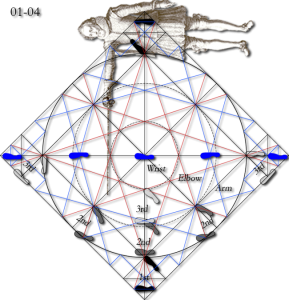
Measure:
1. In measure, measure (able to hit in middle time).
2. Close enough to place sword on opponents elbow,
3. Able to strike opponent while holding body upright.
Attacks:
1st Instance movement by arm.
2nd Instance movement by elbow.
3rd Instance movement by wrist.

On Proportions: “All persons of judgment confess that it would be greatly to be desired, for skill in the exercise of arms, if there were one certain and inviolable measure according to which all distances could be regulated exactly, and therefore all movements as well, great and small, slow and fast. Since our subject is the movements which are made by means of the sword, and with the limbs of the body, the most obvious measure would be that found in the proportions of Man himself.”
The way to draw the sword while advancing:“The occasion to draw the sword while advancing presents itself when the enemy is in front of us at a reasonable distance. For to move back in a situation so necessary and so evident as this would arouse courage in the adversary by a kind of retreat. This is why it is necessary to go forward, against him, meeting him with a spirited resolve; for it is better to do one’s duty with courage than to do so under constraint. Step forward and draw your sword, by means of the four figures marked A, B, C, and D.”
The way to draw the sword while retreating: “When one finds oneself in the company of several persons, that instead of conversing courteously together, some questions come up concerning which one is forced to resort to arms. This is quite difficult and dangerous to do, especially as it is ordinary while in company to stand so close to the others that someone might easily be able to spring upon our body, or seize our arm or the hilt of our sword, in order to deprive us of the means of self-defense. The remedy is to draw the sword while retreating. Shown in figures E, F, G and H.”
Posture of the Straight Line: This is a brief summary of some of the concepts presented in chapter four, followed by a brief description of how to enter on the “straight line” which is for instruction only. When it comes to sparing, the duelist must always hold themselves as though attacking, whether the opponent is holding themselves still, advancing, or moving the sword about.
“There is no posture of the body and no way of holding the sword, which is qualified by all possible advantages, and in which one ought to stop to await the attack.”
“Continue to move, using a free and natural pace, toward one or the other sides, avoiding the line of the diameter where the body of the enemy is drawn up, in inequality. In order to fight well it is necessary to have the advantage. When an opponent comes into measure, assure yourself of their blade, by subjecting, binding, covering, or carrying out an estocade of first intention along it, as convenient; Continuing to move always without interruption.”
“The position of the feet is not only proper for presenting the sword in the straight line, but also for holding one’s forces always united, the body naturally nimble for all changes, and for transporting itself easily from one place to another.”
“Since the feet control all the movements, there is nothing more necessary than to clearly understand the most convenient and natural position for them, step lightly and quickly.”
Both duelist start at the 1st instance (opponents tip not extending beyond your guard) this is the foundation of all measures, and the starting point to all assaults and defenses. Center your gravity above the Extended Diameter, right foot aligned with the quadrangle (along the Inscribed square), presenting a narrow profile to your opponent. Align yourself opposite your opponent, who is in equality with you.
As you nimble step to the 2nd Instance (lead foot quickly followed by the other, think “dance” maintain balance, avoid over extending) either to the left or right you will be stepping off your opponents profile while maintaining your own.
duel (This is an animated pdf that only appears to work in i.e.)
I Saw this poster on face book, “There is many a true word spoken in jest”
No one but the practitioner can assume any liability for the use or misuse of this information, nor should anyone feel encouraged to use these martial art techniques for anything other than personal development and historical study.
Study of historical martial arts can be dangerous and should only be practiced under the guidance of a qualified instructor, or within organized enactment society such as

